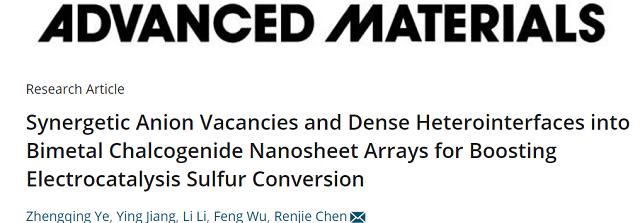"Battery cathode materials are developing towards high nickelization, cobalt-free, and single crystallization. In terms of electrolyte materials, solid electrolytes are the main research directions at present. On April 28, at the 2022 "Lithium Battery Capital" Industrial Ecology and Supply Chain Conference held in Shehong City, Sichuan Province, Wu Feng, academician of the Chinese Academy of Engineering and chief professor of the Department of Energy and Environmental Materials of Beijing Institute of Technology, shared the research and prospects of the new green secondary battery and its key materials.
According to Wu Feng, the energy density of lithium-sulfur (Li-S) batteries developed by the research team of Beijing Institute of Technology has reached 651 Wh/kg by constructing countermeasures such as reactions, strengthening interfaces, and inhibiting dendrite growth. The research results on catalytic materials for high-performance lithium-sulfur batteries were published in Advanced Materials, a top international journal in the category of materials, in April this year.

At present, the energy density of lithium-ion batteries is about 260 Wh/kg. Lithium-sulfur batteries have higher energy density than lithium-ion batteries, and are cheaper and more environmentally friendly, but due to their lower magnification performance, cycle life and safety, there is still a certain distance from commercialization.
In the research and development of a new generation of lithium-ion batteries, in order to break through the ultimate energy density of lithium-ion batteries, the research team of Beijing Polytechnic Institute introduced anion-ion collaborative charge compensation in the study of high-capacity cathode materials, transitioning from the single-electron reaction of traditional lithium-ion batteries to the multi-electron reaction. According to Wu Feng, the scientific research team is also studying a new battery system with both energy density and high power density, and improving the functional characteristics of the battery through the surface structure of the electrode and the functional regulation of the interface.
In terms of new material batteries, the specific capacity of the aluminum-ion cathode material studied by the research team of Beijing Polytechnic University reaches 467 mA per gram, which provides a material basis for the improvement of the energy density of aluminum-ion batteries. In addition, Wu Feng believes that at present, sodium-ion batteries have opened up a new source of raw materials, because of their abundant raw materials and wide distribution, they have certain cost advantages and development potential.
In terms of battery safety, the research team of Beijing Polytechnic Technology started from the primitive steps of regulating and cutting off the electrode reaction, and invented safety materials such as temperature-sensitive electrodes, ceramic high-strength separators, and safety electrolytes. According to Wu Feng, the new generation of gel solid electrolyte developed by the team has greatly improved its safety and can remain non-combustible for 60 seconds at a high temperature of 1300 degrees.
In addition, Wu Feng envisioned the innovation of battery systems from analog to digital. He said: "We are developing smart batteries and smart battery systems that use semiconductor processes to prepare batteries. In the future, large chips will enter the inside of the battery, and the emergence of smart batteries will subvert the structure of the battery system, further improve the safety of power batteries, and become an important part of the intelligence of new energy vehicles. ”
Wu Feng pointed out that material innovation, technological breakthroughs, production capacity, and cost are common issues facing China's power battery companies at present.
At present, China has become the country with the highest production and sales of lithium batteries in the world. In 2021, the installed capacity of global power batteries increased by 102% year-on-year, and the total installed capacity of its Chinese battery companies continued to remain the first in the world. According to the "China Lithium Battery Industry Development Index White Paper" released at the meeting, it is expected that by 2025, the overall market size of China's lithium batteries will reach 865GWh.
In the process of achieving the "double carbon" goal, the new secondary battery is a hot spot in the international competition for research and development, and the United States, the European Union, Japan, South Korea and other developed countries have successively proposed high-performance battery strategic development plans. "Patent barriers in developed countries may cause the risk of card necks, and we need to ensure that the core technology of high-performance batteries is autonomous and controllable." Wu Feng said.
Academician Wu Feng has long been engaged in the research and development of new secondary batteries and related energy materials, and has taken the lead in proposing the academic idea of using light elements, multi-electron and multi-ion reaction systems to achieve leapfrog improvement of battery energy density, and developed a new system and key materials for high-specific secondary batteries. Since the end of the 1980s, Academician Wu Feng has served as the first responsible expert of the national 863 high-tech program, and has taken the lead in organizing and leading the research and development of key materials for lithium batteries, new hydrogen storage materials, nickel-metal hydride batteries and lithium-ion batteries in China.
It is worth mentioning that Academician Wu Feng invented the lithium-containing hydrogen storage alloy and its preparation method, broke the patent monopoly of foreign hydrogen storage alloys, presided over the creation of the first nickel-metal hydride battery pilot base in the mainland, realized the integration of key technologies of industrialization, designed and built the first nickel-metal hydride battery automation demonstration production line in the mainland; developed a series of nickel-metal hydride power battery packs, and successfully applied them to a variety of hybrid vehicles.